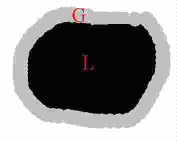
Potatoes and Dragons: Chimeras
Golden Wonder is a interesting plant because it contains the cells of two different types of potato. In botanical terms this is called a chimera. You may remember from your childhood that a chimera is a mythical beast having the claws of an eagle, the tail of a dragon and the body of a lion, if my memory serves correctly. A botanical chimera is similarly made up of bits and pieces...the first one to be discovered was in 1825 when a French nurseryman grafted a piece of Cytisus purpureas (broom) onto laburnum. From where the bud was inserted a shoot developed which was different from both species. The shoot produced flowers which in form and colour were intermediate between the two species, and the leaves were also intermediate in size. The behaviour of the tree, in occasionally producing branches which were entirely laburnum and others which were entirely Cytisus caused a lot of discussion. Eventually it was shown that the tree was a chimera with a core of laburnum and a surface layer of Cytisus, and this was given the name Cytisus Adami. There are other examples: hawthorn-medlar is similarly interesting.
So - how does this relate to potatoes? Well, going back to Golden Wonder ....This potato is very dry, a floury potato, with a brown russet skin and striking purple and yellow flowers. When you sow Golden Wonder, most of the tubers you get are as expected, but occasionally you get a cluster of tubers which are pure white and smooth skinned. The first time that this happened to me I blamed the seed company, but it happened year after year, and finally I found out why. Golden Wonder is actually a "periclinal chimera": the outer skin consists of a layer of cells of Golden Wonder, but the core consists of cells of the variety Langworthy, from which Golden Wonder was originally produced as a russet "sport". This is shown in the diagram (cell types shown as G and L).
 In addition to different skin colours of the tubers, these varieties
differ in other ways. Langworthy generally gives a higher yield, and is a little more floury when cooked than Golden Wonder.
In addition to different skin colours of the tubers, these varieties
differ in other ways. Langworthy generally gives a higher yield, and is a little more floury when cooked than Golden Wonder.
Crane, in 1936, did an interesting experiment with Golden Wonder. He took a tuber and cut it in half. The first half he planted and obtained brown russet-skinned tubers, as expected. From the second half, he scooped out all of the eyes. When shoots developed they came from the core of the potato, and the tubers were white skinned and smooth - Langworthy. There is a remarkable photograph of this in his book "The Genetics of Garden Plants" on page 177. (Macmillan, 1938) Since it's more than 50 years after the publication date, I'm putting this picture below for those who are interested.

Nigel Deacon / Diversity website